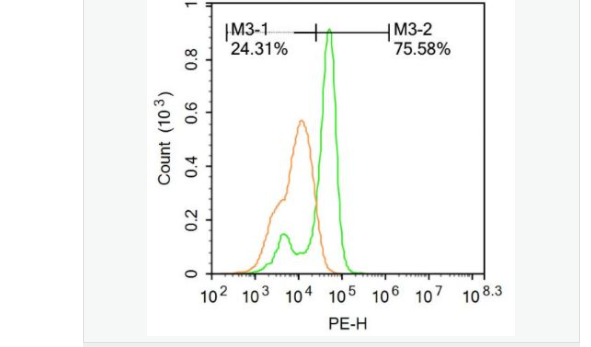
货号
产品规格
售价
备注
BN40826R-100ul
100ul
¥2470.00
交叉反应:Human(predicted:Mouse,Rat,Chicken,Dog,Pig,Cow,Horse) 推荐应用:WB,Flow-Cyt,ELISA
| 英文名称 | phospho-NFATc2 (Ser326) |
| 中文名称 | 磷酸化核因子活化T细胞胞浆蛋白2抗体 |
| 别 名 | AI607462; KIAA0611; NF ATp; NF-ATc2; NFAT 1; NFAT pre existing subunit; NFAT transcription complex, preexisting component; NFAT1; NFAT1-D; NFATc2; NFATp; Nuclear factor of activated T cells cytoplasmic 2; Nuclear factor of activated T cells cytoplasmic calcineurin dependent 2; Nuclear factor of activated T cells pre-existing component; T cell transcription factor NFAT; NF2IP_HUMAN; Nuclear factor of activated T-cells, cytoplasmic 2; NFAT pre-existing subunit; NF-ATp; T-cell transcription factor NFAT1. |
| 产品类型 | 磷酸化抗体 |
| 研究领域 | 信号转导 细胞凋亡 转录调节因子 激酶和磷酸酶 |
| 抗体来源 | Rabbit |
| 克隆类型 | Polyclonal |
| 交叉反应 | Human, (predicted: Mouse, Rat, Chicken, Dog, Pig, Cow, Horse, ) |
| 产品应用 | WB=1:500-2000 ELISA=1:5000-10000 Flow-Cyt=1ug/test not yet tested in other applications. optimal dilutions/concentrations should be determined by the end user. |
| 分 子 量 | 102kDa |
| 细胞定位 | 细胞核 细胞浆 |
| 性 状 | Liquid |
| 浓 度 | 1mg/ml |
| 免 疫 原 | KLH conjugated Synthesised phosphopeptide derived from human NFATc2 around the phosphorylation site of Ser326:KT(p-S)PD |
| 亚 型 | IgG |
| 纯化方法 | affinity purified by Protein A |
| 储 存 液 | 0.01M TBS(pH7.4) with 1% BSA, 0.03% Proclin300 and 50% Glycerol. |
| 保存条件 | Shipped at 4℃. Store at -20 °C for one year. Avoid repeated freeze/thaw cycles. |
| PubMed | PubMed |
| 产品介绍 | This gene is a member of the nuclear factor of activated T cells (NFAT) family. The product of this gene is a DNA-binding protein with a REL-homology region (RHR) and an NFAT-homology region (NHR). This protein is present in the cytosol and only translocates to the nucleus upon T cell receptor (TCR) stimulation, where it becomes a member of the nuclear factors of activated T cells transcription complex. This complex plays a central role in inducing gene transcription during the immune response. Alternate transcriptional splice variants encoding different isoforms have been characterized. [provided by RefSeq, Apr 2012] Function: Plays a role in the inducible expression of cytokine genes in T-cells, especially in the induction of the IL-2, IL-3, IL-4, TNF-alpha or GM-CSF. Promotes invasive migration through the activation of GPC6 expression and WNT5A signaling pathway. Subunit: Member of the multicomponent NFATC transcription complex that consists of at least two components, a pre-existing cytoplasmic component NFATC2 and an inducible nuclear component NFATC1. Other members such as NFATC4, NFATC3 or members of the activating protein-1 family, MAF, GATA4 and Cbp/p300 can also bind the complex. The phosphorylated form specifically interacts with XPO1; which mediates nuclear export. NFATC proteins bind to DNA as monomers. Interacts with NFATC2IP. Subcellular Location: Cytoplasm. Nucleus. Note=Cytoplasmic for the phosphorylated form and nuclear after activation that is controlled by calcineurin-mediated dephosphorylation. Rapid nuclear exit of NFATC is thought to be one mechanism by which cells distinguish between sustained and transient calcium signals. The subcellular localization of NFATC plays a key role in the regulation of gene transcription. Tissue Specificity: Expressed in thymus, spleen, heart, testis, brain, placenta, muscle and pancreas. Post-translational modifications: In resting cells, phosphorylated by NFATC-kinase on at least 18 sites in the 99-365 region. Upon cell stimulation, all these sites except Ser-245 are dephosphorylated by calcineurin. Dephosphorylation induces a conformational change that simultaneously exposes an NLS and masks an NES, which results in nuclear localization. Simultaneously, one site among Ser-53; Ser-54 and Ser-56 is phosphorylated; which is required for full transcriptional activity. Similarity: Contains 1 RHD (Rel-like) domain SWISS: Q13469 Gene ID: 4773 Database links: Entrez Gene: 4773 Human Entrez Gene: 18019 Mouse Omim: 600490 Human SwissProt: Q13469 Human SwissProt: Q60591 Mouse Unigene: 713650 Human Unigene: 744148 Human Unigene: 116802 Mouse Unigene: 33679 Rat Important Note: This product as supplied is intended for research use only, not for use in human, therapeutic or diagnostic applications. |
